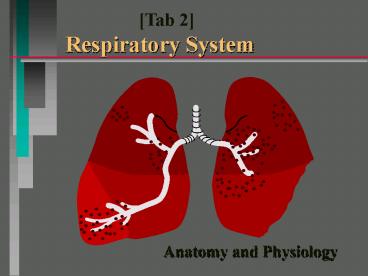Types of Hazards - PowerPoint PPT Presentation
1 / 22
Title: Types of Hazards
1
Tab 2Respiratory System
Anatomy and Physiology
2
1910.134(b)(10)Respiratory Protection
- Persons should not be assigned to tasks
requiring use of respirators unless it has been
determined that they are physically able to
perform the work and use the equipment.
3
Conditions which may limit respirator use
- any lung disease (e.g., emphysema, COPD,
allergies, asthma) - x-ray evidence of pneumoconiosis
- reduced pulmonary function
- heart disease
- cerebral blood vessel disease
- hypertension
4
The Pulmonary System
- Exchange Oxygen and Carbon Dioxide
- Conduit and Oxygen Exchange Area
5
Respiratory System
- function
- gas exchange between atmosphere blood
- parts
- upper respiratory system
- mouth, nose, pharynx, larynx
- lower respiratory system
- trachea, bronchi, bronchioles, lungs
6
The Lungs
- very large surface area
145 M2 in healthy male (or, about 40 times
greater than surface area of our external skin) - very thin membrane required at gas exchange area
only 1/2 to 1
micron thick in healthy persons - micron?
7
(No Transcript)
8
(No Transcript)
9
Micron
- one millionth of a meter
- about 1/ 1000th the size of a hair
- um
10
The Nose
- Warms, cools air
- Humidifies air
- Filters particulates gt 10 microns (nose hairs
and turbinate impaction) - Reacts with water soluble gases
- Preferred entrance of air
11
The Pharynx
- the chamber which collects incoming air and food
- passes air to trachea
- regulates air pressure and velocity
- filters particles (2 to 10 microns) through
impaction - reacts with water soluble gases
12
Conducting Airways (Conduit)
- Trachea, Bronchi, Segmental Bronchi,
Nonrespiratory Bronchioles - Ciliated, Mucus Secreting
- Reduce in Diameter, Air Velocity the Further Down
in System, Mucus Velocity - Increase in Number of Generations, Surface Area
13
The Trachea
- passage from pharynx to lungs
- the windpipe
- largest conduit to lungs
- filters particles 2 to 10 microns
- very sensitive (cough reflex)
14
(No Transcript)
15
The Bronchi
- two subdivisions of the trachea
- one for each lung
- further subdivide into segmental bronchi
- filters particles 2 to 10 microns
16
The Bronchioles
- smaller subdivisions of bronchi
- lower velocity settling
- flow less turbulent
- removes particles from 2 to 0.5 microns
- smooth muscle layer constricts
17
The Alveoli (Air Exchange)
- respiratory bronchioles and alveolar ducts
- small air sacs
- covered with capillaries
- pulmonary artery
- pulmonary vein
- immunologic protection (macrophage)
18
The Alveoli (Air Exchange)
- respiratory bronchioles and alveolar ducts
- small air sacs
- covered with capillaries
- immunologic protection (macrophage)
19
Factors Determining Deposition
- size
- density
- shape (fiber, aspect ratio)
- solubility (water vs lipid)
- chemical composition (toxic vs inert)
20
- The following slides are not for the class to
see, but rather just instructor notes
21
Types of Pulmonary Disease
- Obstructive- larger airways asthma, bronchitis,
COPD, emphysema - Restrictive- lung cannot expand fully or oxygen
transfer inhibited hypersensitivity pneumonitis,
asbestosis, silicosis, black lung, berylliosis
22
Emphysema
- --occurs when adjacent walls in alveoli break
through, causing a reduction in the number of air
sacs - --this decreases the total gas exchange surface
that is available - --over time, the lung becomes less elastic, and
the outflow of air is obstructed
23
Chronic bronchitis
- -- inhaled irritants cause excessive production
of mucous in lower respiratory passages - --they also cause inflammation fibrosis
(hardening) of the skin surface (mucosa) - --the result airway obstruction, poor
ventilation of lungs, interference with the gas
exchange process - --also, bacteria thrive in the mucous, so
pulmonary infections often occur
24
Types of Defense
- nose hairs/ turbinates
- impaction / centrifugal / cyclonic
- cough reflex, sneeze reflex
- mucus blanket, ciliated cells
- bronchioconstriction
- settling, Brownian motion
- immune response
25
Protective Measures
- Many of these defense mechanisms can
deteriorate with age, or be compromised as a
result of illness, tobacco smoking, or exposure
to chemical irritants. - So, choose control your exposures wisely!































